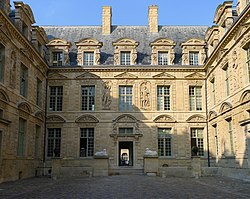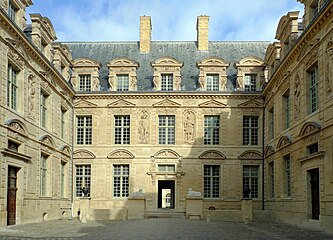| Hôtel de Sully | |
|---|---|
 | |
| General information | |
| Type | Hôtel particulier |
| Architectural style | Louis XIII style |
| Address | 62, rue Saint-Antoine |
| Town or city | Paris |
| Country | France |
| Construction started | 1624 |
| Completed | 1630 |
| Design and construction | |
| Architect(s) | Jean Androuet du Cerceau |
| Website | |
| http://www.hotel-de-sully.fr/en/ | |
The Hôtel de Sully is a Louis XIII style hôtel particulier, or private mansion, located at 62 rue Saint-Antoine in the Marais, IV arrondissement, Paris, France. Built at the beginning of the 17th century, it is nowadays the seat of the Centre des Monuments Nationaux, the French national organization responsible for national heritage sites. It has been listed since 1862 as a monument historique by the French Ministry of Culture.
History
The Hôtel de Sully was built, with gardens and an orangery, between 1624 and 1630, for the wealthy financier Mesme Gallet. The building is usually attributed to the architect Jean Androuet du Cerceau. The site was chosen to give access to the Place Royale - today the Place des Vosges. The Marais was then an especially fashionable area for the high nobility ; the construction of the Hôtel de Sully fits in a larger movement of monumental building in this part of Paris.
Maximilien de Béthune, Duke of Sully, and former Superintendent of Finances to King Henri IV, purchased the hôtel, completed and fully furnished, on 23 February 1634. He completed the redecoration of the building, and spent his last years living there. His grandson Maximilien commissioned architects, most probably Simon Lambert and François Le Vau, to build an additional wing in 1660, to the west of the garden. The Hôtel de Sully still bears the name of this family, who owned the building into the 18th century.
The hôtel then passed through the hands of various owners, becoming an investment property in the 19th century. Various additions and alterations were made, to accommodate trades, craftsmen and other tenants. In 1862 it was classified as a monument historique, and new owners, more concerned with conservation, gradually restored the building. It became a state-owned property in 1944. A long restoration programme was then undertaken, which was completed with the repair of the orangery in 1973.
Since 1967 it has been the home of the Caisse Nationale des Monuments Historiques et des Sites, which in 2000 became the Centre des Monuments Nationaux. This public body, under the supervision of the Ministry of Culture and Communication, is responsible for the management of historic buildings and monuments in state care.
Gallery
-
 Façade facing the rue Saint-Antoine
Façade facing the rue Saint-Antoine
-
 Main building from the courtyard
Main building from the courtyard
-
 Allegorical bas-reliefs by Jean Goujon ; on the left, Fall, on the right, Winter.
Allegorical bas-reliefs by Jean Goujon ; on the left, Fall, on the right, Winter.
-
 Detail of the east gallery.
Detail of the east gallery.
-
Main portal from the courtyard
-
Nord façade, facing the garden,
-
 Garden and orangery
Garden and orangery
-
 The orangery's sundial
The orangery's sundial
References
- Base Mérimée: PA00086278, Ministère français de la Culture. (in French) Hôtel Béthune-Sully
- Gady 2008, 184.
- Gady 2008, 30.
- Gady 2008, 184.
- Gady, Alexandre (2002). L'hôtel de Sully. Itinéraires. Éditions du patrimoine. ISBN 9782858223442.; English edition (2008): ISBN 9782757700037.
- Gady, Alexandre (2008). Les hôtels particuliers de Paris, du Moyen-Âge à la Belle époque. Paris: Parigramme.
External links
- Hôtel de Sully, Centre des monuments nationaux (English language web site)
| 4th arrondissement of Paris | |
|---|---|
| Neighbourhoods |
|
| Primary and secondary schools | |
| Islands |
|
| Landmarks |
|
| Paris Métro stations | |
| Healthcare |
|